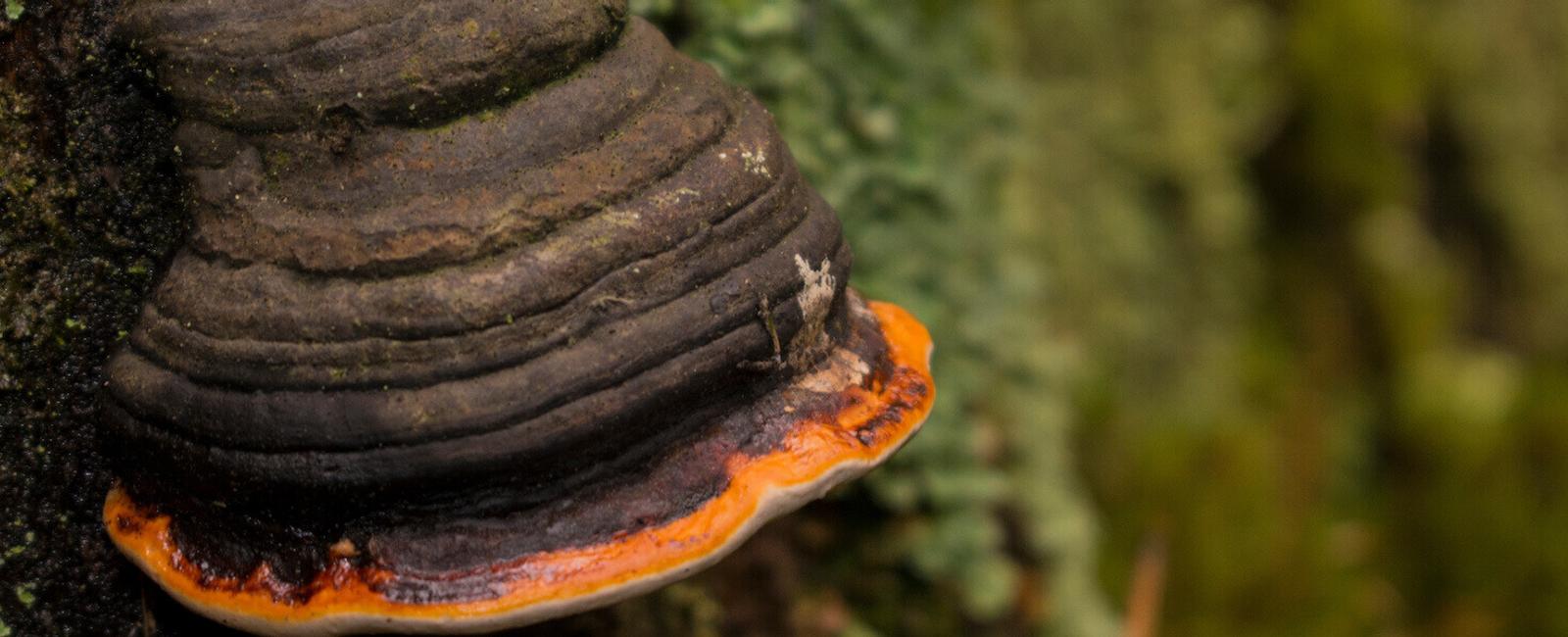

You may have noticed that medicinal mushrooms are everywhere lately. From mushroom coffee to mushroom skincare, these unique fungi are more popular and widely available than ever. And one, in particular, stands out: chaga mushrooms, sometimes called “king healer mushrooms” (a nod to their therapeutic properties).
In this guide to chaga mushrooms, we’ll talk about what they are, how they’ve been used in traditional medicine schools, and much more. So grab a cup of tea (maybe chaga tea?) and let’s learn more about one of nature’s greatest gifts.
What are chaga mushrooms?
Chaga mushrooms (inonotus obliquus) are a fascinating edible fungus revered for their healing abilities. It’s known by other common names depending on region and culture; you may see chaga mushrooms referred to as clinker polypore, cinder conk, black mass, diamond of the forest, and kabanoanatake in Japanese.
Usually, when we see a mushroom out on a hike or gracing the produce section, we see the fruiting body. But another vital aspect of mushroom anatomy we seldom see or come into contact with is the mycelium. Chaga mushrooms are unique because what we see isn’t the fruiting body; it’s a highly condensed bundle of mycelium.
Psst: The name “chaga” comes from the word for mushroom in the Komi-Permyak language spoken by indigenous peoples native to the Ural mountains (1). It’s thought they were the first to take advantage of chaga mushrooms’ incredible health benefits (2).
What do chaga mushrooms look like?
These mushrooms don’t look like your typical mushroom. Chaga mushrooms don’t have a cap or stem; they grow into conks. This conk is a solid mass that looks like burnt charcoal (but reddish brown on the inside) and is extremely hard—harvesting generally requires a sharp knife or hatchet.
A chaga conk can grow to be as large as 30 inches long and 20 inches wide, and while they favor birch trees, you can find them on alder, aspen, and elm trees too. Chaga is a parasitic fungus, so most of the trees hosting a chaga conk have died or are in the process of dying.
Once chaga has been harvested from a tree, the conk will grow back to its original size, which can take 20 years or more (3).
Where do chaga mushrooms grow?
Even though chaga mushrooms will grow on other types of trees, most of the time, you can expect to see chaga conks growing on birch trees in the Northern Hemisphere, favoring cold climates.
Northern European countries such as Finland, Norway, and Sweden have many birch forests where chaga can make a happy home. Chaga mushrooms are widespread in countries like Russia, Siberia, and North America in Canada, Alaska, Minnesota, and parts of New England (1).
Historical and medicinal use of chaga mushrooms

Chaga mushrooms were traditionally used in folk medicine, particularly in Eastern European countries, before they became a fixture in traditional Chinese medicine.
This unique fungus was used to prevent cancer, manage blood sugar, protect the heart, assist with reducing inflammation in the body, and boost the immune system. Other uses included treating tuberculosis, liver, and digestive issues. Some Siberian villages continue to make chaga tea the same way their ancestors did thousands of years ago (1).
In traditional Chinese medicine, chaga mushrooms have an effect on the spleen, stomach, liver, and kidney meridians and help build qi, calm shen, restore the blood, tonify the liver, kidneys, and spleen, and clear toxins in the body (4).
Psst: Ötzi, the iceman, was killed 5,300 years ago, although his frozen body wasn’t discovered in the Alps until 1991. What he wore and carried helped tell an invaluable story about our ancestors and how they lived. Researchers found he was carrying a stone dagger and, among other possessions, birch fungus. While we can’t say with certainty that Ötzi was carrying chaga mushrooms with him (since not all birch fungus is chaga), he may have been (5).
Health benefits of chaga mushrooms
Referring to chaga mushrooms as the king healer mushroom isn’t without cause. The unique combination of beta-glucans, triterpenes, and inonotus obliquus polysaccharides (a type of complex carbohydrate specific to chaga) all contribute to chaga’s ability to positively affect the human body. Here are some ways chaga mushrooms can nurture and support your overall wellness.
High in antioxidants
Chaga mushrooms are a high-antioxidant food, which means they’re great at mopping up free radicals in your body.
But first, it’s time for a quick science lesson—it’ll be painless, we promise!
Molecules are comprised of atoms, and atoms like to be paired up with other atoms to make them stable. But when atoms are missing a partner, they turn into free radicals. Think of free radicals as little fires that start in various rooms of your house. Antioxidants are like the firefighters that come and put those fires out and patrol your home to ensure any other fires that start are swiftly put out.
Without antioxidants, all those free radicals create inflammation and oxidative stress in your body, eventually leading to pain, disease, and accelerated aging. In this context, you can think of chaga mushrooms as having an anti-aging effect on your body.
Psst: A study found that cells pre-treated with chaga mushroom had up to 40% less free radical damage than the control (6).
Blood sugar management
Monitoring blood sugar levels is essential, especially if you have diabetes. A study involving mice found that diabetic mice fed chaga mushrooms had lower blood sugar and insulin levels than mice that didn’t consume chaga (7).
Immune system support
Recent studies have demonstrated chaga’s impressive effects on the immune system. Chaga positively impacts the production of white blood cells. It also positively affects lymphocytes and cytokines; the latter are proteins that act as chemical messengers and help the cells in your body communicate with each other (6).
Both in vitro and animal studies investigating the power of chaga mushrooms are also promising as chaga shows an ability to not only prevent but also slow down the growth of cancer cells. Further research indicates that chaga fights cancer cells of varying kinds, including liver, lung, breast, prostate, and colon cancer (7).
Reduced cholesterol levels
Researchers are still learning how chaga mushrooms have the effect they do on cholesterol levels, but what they’ve learned is encouraging. Somehow, chaga mushrooms help to lower not-so-great LDL cholesterol while raising good cholesterol levels. This may have positive implications for managing heart disease. Scientists surmise the exact mechanism that affects cholesterol might also be responsible for decreasing inflammation in the body (6).
Remember, chaga supplements aren’t regulated by the Food and Drug Administration (FDA), and this is not medical advice. While chaga is generally safe for most people, there can be side effects for some. If you’re on blood-thinning medication, have blood clotting issues, or suffer from bleeding disorders, consult your healthcare provider.
Ethically wildcrafting chaga mushrooms

Before you decide you’re ready to venture out into the wild searching for chaga mushroom conks, it’s essential to consider the differences between foraging and ethically wildcrafting chaga mushrooms. While they may seem similar, there are distinctions you’ll want to be mindful of.
Foraging is generally defined as gathering wild food sources. On the flip side, wildcrafting is harvesting local resources for medicinal needs. So while these terms seem interchangeable, the real difference comes down to each respective approach to harvesting.
Wildcrafting mushrooms, plants, herbs, nuts, or other wild food sources keeps the local ecosystem front of mind. There’s a consideration as to which species in an area are endangered or threatened, and there’s time spent identifying any dangerous lookalikes one could encounter while mushroom hunting.
Even more, instead of simply haphazardly gathering mushrooms, care is taken to learn how to harvest a resource. Careless collecting of mushrooms can damage the delicate mycelium beneath the surface, and overharvesting can have grave implications in a fragile environment. After all, humans aren’t the only ones that enjoy feasting on a mushroom or two. Deer, birds, and other insects rely on them as food sources, which is all the more reason to be aware of how we approach harvesting.
Gathering mushrooms is a lovely way to connect with your food, the land, and everything nature has to offer. By taking extra time to educate ourselves, we can ensure others can continue following in the footsteps of our ancestors for generations to come.
How can you enjoy chaga mushrooms?

Unlike culinary and medicinal mushrooms you may be familiar with, chaga mushrooms aren’t typically consumed similarly. These differ from the type of mushrooms you pick up at the supermarket and toss into an evening stir-fry. Remember, chaga mushrooms are essentially a bundle of tightly woven mycelium, so they’re nothing like the texture of the white button or enoki mushrooms you’re used to.
Instead, chaga mushrooms are best enjoyed and prepared as a sort of herbal tea or after they’ve been ground into a fine mushroom powder.
Chaga mushroom extract occurs through the processing magic of using different solvents such as hot water or alcohol. The health benefits of chaga extract will depend on which method is used—ideally, you want both—as the bioactive compounds extracted from the mushroom rely on the processing method.
When shopping for chaga supplements, look for companies that openly share their sourcing and processing methods. You might see ratios listed on the label or mention third-party testing, letting you know your chaga mushroom powder is free from contaminants. Most companies will clearly label whether or not their chaga product is a dual extraction. It’s safe to assume it’s a water-only extraction if it doesn’t say.
Lastly, it’s always wise to shop from companies that share their sustainability and harvesting practices. Chaga mushrooms can take a long time to grow, and like many natural resources, they aren’t immune to overharvesting.
Chaga mushrooms: Nature’s ultimate mushroom powerhouse
Few mushrooms are as revered as chaga mushrooms. And with all its health benefits, it’s no wonder why it earned its moniker of being the king healer mushroom. From immune system support to improving digestive health and much more, this is one medicinal mushroom you’ll want to make part of your daily routine.
Craving more mushrooms in your life? Keep up on all mushroom happenings, including the latest breakthrough discoveries on medicinal and psychedelic mushrooms and other news on shroomer.
References
- Hobbs, Christopher, PhD. Christopher Hobb’s Medicinal Mushrooms: The Essential Guide. Storey Publishing, LLC, 2021. https://christopherhobbs.com/hobbs-news-archive/christopher-hobbss-medicinal-mushrooms-the-essential-guide/.
- DrWeil.com. “Choose Chaga Mushrooms? | Nutrition | Andrew Weil, M.D.,” March 15, 2023. https://www.drweil.com/diet-nutrition/nutrition/choose-chaga-mushrooms/.
- UMN Extension. “Chaga - a Delicious Find in the Winter Woods,” February 3, 2021. https://extension.umn.edu/my-minnesota-woods/chaga-delicious-find-winter-woods.
- White Rabbit Institute of Healing. “Chaga | White Rabbit Institute of Healing,” June 17, 2019. https://www.whiterabbitinstituteofhealing.com/herbs/chaga/.
- Griggs, Mary Beth. “The Iceman Wore Five Different Animal Products When He Died.” Popular Science, April 26, 2021. https://www.popsci.com/iceman-wore-five-different-animal-products-on-his-final-journey/?dom=currents&src=syn.
- Muinos, Lacey. “6 Promising Benefits of Chaga Mushrooms, According to Research.” Real Simple, May 15, 2023. https://www.realsimple.com/chaga-mushroom-benefits-7498302.
- Conklin, Lisa Marie. “5 Reasons to Consider Chaga Mushrooms - American Association of Naturopathic Physicians.” American Association of Naturopathic Physicians, May 13, 2021. Accessed May 29, 2023. https://naturopathic.org/news/565437/5-Reasons-to-Consider-Chaga-Mushrooms.htm


